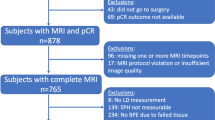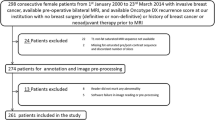Abstract
Purpose
To determine whether a multivariate machine learning-based model using computer-extracted features of pre-treatment dynamic contrast-enhanced magnetic resonance imaging (DCE-MRI) can predict pathologic complete response (pCR) to neoadjuvant therapy (NAT) in breast cancer patients.
Methods
Institutional review board approval was obtained for this retrospective study of 288 breast cancer patients at our institution who received NAT and had a pre-treatment breast MRI. A comprehensive set of 529 radiomic features was extracted from each patient’s pre-treatment MRI. The patients were divided into equal groups to form a training set and an independent test set. Two multivariate machine learning models (logistic regression and a support vector machine) based on imaging features were trained to predict pCR in (a) all patients with NAT, (b) patients with neoadjuvant chemotherapy (NACT), and (c) triple-negative or human epidermal growth factor receptor 2-positive (TN/HER2+) patients who had NAT. The multivariate models were tested using the independent test set, and the area under the receiver operating characteristics (ROC) curve (AUC) was calculated.
Results
Out of the 288 patients, 64 achieved pCR. The AUC values for predicting pCR in TN/HER+ patients who received NAT were significant (0.707, 95% CI 0.582–0.833, p < 0.002).
Conclusions
The multivariate models based on pre-treatment MRI features were able to predict pCR in TN/HER2+ patients.


Similar content being viewed by others
References
von Minckwitz G, Untch M, Blohmer J-U et al (2012) Definition and impact of pathologic complete response on prognosis after neoadjuvant chemotherapy in various intrinsic breast cancer subtypes. J Clin Oncol 30(15):1796–1804. https://doi.org/10.1200/JCO.2011.38.8595
Kaufmann M, von Minckwitz G, Bear HD et al (2007) Recommendations from an international expert panel on the use of neoadjuvant (primary) systemic treatment of operable breast cancer: new perspectives 2006. Ann Oncol 18(12):1927–1934. https://doi.org/10.1093/annonc/mdm201
Kaufmann M, von Minckwitz G, Smith R et al (2003) International expert panel on the use of primary (preoperative) systemic treatment of operable breast cancer: review and recommendations. J Clin Oncol 21(13):2600–2608. https://doi.org/10.1200/JCO.2003.01.136
Heys SD, Hutcheon AW, Sarkar TK et al (2002) Neoadjuvant docetaxel in breast cancer: 3-year survival results from the Aberdeen trial. Clin Breast Cancer 3:S69–S74. https://doi.org/10.3816/CBC.2002.s.015
van der Hage JH, van de Velde CC, Mieog SJ (2007) Preoperative chemotherapy for women with operable breast cancer. In: Mieog SJ (ed) Cochrane database of systematic reviews. John Wiley & Sons, Ltd, Chichester. https://doi.org/10.1002/14651858.CD005002.pub2
Fisher B, Bryant J, Wolmark N et al (1998) Effect of preoperative chemotherapy on the outcome of women with operable breast cancer. J Clin Oncol 16(8):2672–2685. https://doi.org/10.1200/JCO.1998.16.8.2672
van der Hage JA, van de Velde CJ, Julien JP et al (2001) Preoperative chemotherapy in primary operable breast cancer: results from the European Organization for Research and Treatment of Cancer trial 10902. J Clin Oncol 19(22):4224–4237. https://doi.org/10.1200/JCO.2001.19.22.4224
Michoux N, Van den Broeck S, Lacoste L et al (2015) Texture analysis on MR images helps predicting non-response to NAC in breast cancer. BMC Cancer 15(1):574. https://doi.org/10.1186/s12885-015-1563-8
Barbi GP, Marroni P, Bruzzi P, Nicolò G, Paganuzzi M, Ferrara GB (1987) Correlation between steroid hormone receptors and prognostic factors in human breast cancer. Oncology 44(5):265–269. https://doi.org/10.1159/000226492
von Minckwitz G, Sinn H-P, Raab G et al (2008) Clinical response after two cycles compared to HER2, Ki-67, p53, and bcl-2 in independently predicting a pathological complete response after preoperative chemotherapy in patients with operable carcinoma of the breast. Breast Cancer Res 10(2):R30. https://doi.org/10.1186/bcr1989
Esserman L, Kaplan E, Partridge S et al (2001) MRI phenotype is associated with response to doxorubicin and cyclophosphamide neoadjuvant chemotherapy in stage III breast cancer. Ann Surg Oncol 8(6):549–559. https://doi.org/10.1007/s10434-001-0549-8
Nishimura R, Osako T, Okumura Y, Hayashi M, Arima N (2010) Clinical significance of Ki-67 in neoadjuvant chemotherapy for primary breast cancer as a predictor for chemosensitivity and for prognosis. Breast Cancer 17(4):269–275. https://doi.org/10.1007/s12282-009-0161-5
Fangberget A, Nilsen LB, Hole KH et al (2011) Neoadjuvant chemotherapy in breast cancer-response evaluation and prediction of response to treatment using dynamic contrast-enhanced and diffusion-weighted MR imaging. Eur Radiol 21(6):1188–1199. https://doi.org/10.1007/s00330-010-2020-3
Uematsu T, Kasami M, Yuen S (2010) Neoadjuvant chemotherapy for breast cancer: correlation between the baseline MR imaging findings and responses to therapy. Eur Radiol 20(10):2315–2322. https://doi.org/10.1007/s00330-010-1813-8
Pickles MD, Manton DJ, Lowry MTL (2009) Prognostic value of pre-treatment DCE-MRI parameters in predicting disease free and overall survival for breast cancer patients undergoing neoadjuvant chemotherapy. Eur J Radiol 71(3):498–505. https://doi.org/10.1016/J.EJRAD.2008.05.007
Craciunescu OI, Blackwell KL, Jones EL et al (2009) DCE-MRI parameters have potential to predict response of locally advanced breast cancer patients to neoadjuvant chemotherapy and hyperthermia: A pilot study. Int J Hyperth 25(6):405–415. https://doi.org/10.1080/02656730903022700
Smith IC, Heys SD, Hutcheon AW et al (2002) Neoadjuvant chemotherapy in breast cancer: significantly enhanced response with docetaxel. J Clin Oncol 20(6):1456–1466. https://doi.org/10.1200/JCO.2002.20.6.1456
Kawamura M, Satake H, Ishigaki S, Nishio A, Sawaki M, Naganawa S (2011) Early prediction of response to neoadjuvant chemotherapy for locally advanced breast cancer using MRI. Nagoya J Med Sci 73(3–4):147–156
Goorts B, van Nijnatten TJA, de Munck L et al (2017) Clinical tumor stage is the most important predictor of pathological complete response rate after neoadjuvant chemotherapy in breast cancer patients. Breast Cancer Res Treat 163(1):83–91. https://doi.org/10.1007/s10549-017-4155-2
Braman NM, Etesami M, Prasanna P et al (2017) Intratumoral and peritumoral radiomics for the pretreatment prediction of pathological complete response to neoadjuvant chemotherapy based on breast DCE-MRI. Breast Cancer Res 19(1):57. https://doi.org/10.1186/s13058-017-0846-1
Fan M, Wu G, Cheng H, Zhang J, Shao G, Li L (2017) Radiomic analysis of DCE-MRI for prediction of response to neoadjuvant chemotherapy in breast cancer patients. Eur J Radiol 94:140–147. https://doi.org/10.1016/J.EJRAD.2017.06.019
Eom H-J, Cha JH, Choi WJ, Chae EY, Shin HJ, Kim HH (2017) Predictive clinicopathologic and dynamic contrast-enhanced MRI findings for tumor response to neoadjuvant chemotherapy in triple-negative breast cancer. Am J Roentgenol 208(6):W225–W230. https://doi.org/10.2214/AJR.16.17125
Chamming’s F, Ueno Y, Ferré R et al (2017) Features from computerized texture analysis of breast cancers at pretreatment MR imaging are associated with response to neoadjuvant chemotherapy. Radiology. https://doi.org/10.1148/radiol.2017170143
Aghaei F, Tan M, Hollingsworth AB, Qian W, Liu H, Zheng B (2015) Computer-aided breast MR image feature analysis for prediction of tumor response to chemotherapy. Med Phys 42(11):6520–6528. https://doi.org/10.1118/1.4933198
Aghaei F, Tan M, Hollingsworth AB, Zheng B, Cheng S (2016) Computer-aided global breast MR image feature analysis for prediction of tumor response to chemotherapy: performance assessment. In: Tourassi GD, Armato SG (eds) International society for optics and photonics. https://doi.org/10.1117/12.2216326
Ahmed A, Gibbs P, Pickles M, Turnbull L (2013) Texture analysis in assessment and prediction of chemotherapy response in breast cancer. J Magn Reson Imaging 38(1):89–101. https://doi.org/10.1002/jmri.23971
Nilsen L, Fangberget A, Geier O, Olsen DR, Seierstad T (2010) Diffusion-weighted magnetic resonance imaging for pretreatment prediction and monitoring of treatment response of patients with locally advanced breast cancer undergoing neoadjuvant chemotherapy. Acta Oncol (Madr) 49(3):354–360. https://doi.org/10.3109/02841861003610184
Tudorica A, Oh KY, Chui SY-C et al (2016) Early prediction and evaluation of breast cancer response to neoadjuvant chemotherapy using quantitative DCE-MRI 1. Transl Oncol 9:8–17. https://doi.org/10.1016/j.tranon.2015.11.016
New response evaluation criteria in solid tumours (2009) Revised RECIST guideline (version 1.1). Eur J Cancer 45(2):228–247. https://doi.org/10.1016/J.EJCA.2008.10.026
Bezdek JC (2013) Pattern recognition with fuzzy objective function algorithms. Springer Science & Business Media, New York
Saha A, Yu X, Sahoo D, Mazurowski MA (2017) Effects of MRI scanner parameters on breast cancer radiomics. Expert Syst Appl 87:384–391. https://doi.org/10.1016/j.eswa.2017.06.029
Team RC (2014) R: a language and environment for statistical computing. R Foundation for Statistical Computing, Vienna 2014.
DeLong ER, DeLong DM, Clarke-Pearson DL (1988) Comparing the areas under two or more correlated receiver operating characteristic curves: a nonparametric approach. Biometrics 44(3):837. https://doi.org/10.2307/2531595
Guyon I, Elisseeff A, De AM (2003) An introduction to variable and feature selection. J Mach Learn Res 3:1157–1182
Dave RV, Millican-Slater R, Dodwell D, Horgan K, Sharma N (2017) Neoadjuvant chemotherapy with MRI monitoring for breast cancer. Br J Surg 104(9):1177–1187. https://doi.org/10.1002/bjs.10544
Sharma U, Danishad KKA, Seenu V, Jagannathan NR (2009) Longitudinal study of the assessment by MRI and diffusion-weighted imaging of tumor response in patients with locally advanced breast cancer undergoing neoadjuvant chemotherapy. NMR Biomed 22(1):104–113. https://doi.org/10.1002/nbm.1245
Cleator S, Heller W, Coombes RC (2007) Triple-negative breast cancer: therapeutic options. Lancet Oncol 8(3):235–244. https://doi.org/10.1016/S1470-2045(07)70074-8
Liedtke C, Mazouni C, Hess KR et al (2008) Response to neoadjuvant therapy and long-term survival in patients with triple-negative breast cancer. J Clin Oncol 26(8):1275–1281. https://doi.org/10.1200/JCO.2007.14.4147
Carey LA, Dees EC, Sawyer L et al (2007) The triple negative paradox: primary tumor chemosensitivity of breast cancer subtypes. Clin Cancer Res 13(8):2329–2334. https://doi.org/10.1158/1078-0432.CCR-06-1109
Gianni L, Eiermann W, Semiglazov V et al (2010) Neoadjuvant chemotherapy with trastuzumab followed by adjuvant trastuzumab versus neoadjuvant chemotherapy alone, in patients with HER2-positive locally advanced breast cancer (the NOAH trial): a randomised controlled superiority trial with a parallel HER. Lancet 375(9712):377–384. https://doi.org/10.1016/S0140-6736(09)61964-4
Buzdar AU, Suman VJ, Meric-Bernstam F et al (2013) Fluorouracil, epirubicin, and cyclophosphamide (FEC-75) followed by paclitaxel plus trastuzumab versus paclitaxel plus trastuzumab followed by FEC-75 plus trastuzumab as neoadjuvant treatment for patients with HER2-positive breast cancer (Z1041): a random. Lancet Oncol 14(13):1317–1325. https://doi.org/10.1016/S1470-2045(13)70502-3
Robidoux A, Tang G, Rastogi P et al (2013) Lapatinib as a component of neoadjuvant therapy for HER2-positive operable breast cancer (NSABP protocol B-41): an open-label, randomised phase 3 trial. Lancet Oncol 14(12):1183–1192. https://doi.org/10.1016/S1470-2045(13)70411-X
Untch M, Loibl S, Bischoff J et al (2012) Lapatinib versus trastuzumab in combination with neoadjuvant anthracycline-taxane-based chemotherapy (GeparQuinto, GBG 44): a randomised phase 3 trial. Lancet Oncol 13(2):135–144. https://doi.org/10.1016/S1470-2045(11)70397-7
Cortazar P, Zhang L, Untch M et al (2014) Pathological complete response and long-term clinical benefit in breast cancer: the CTNeoBC pooled analysis. Lancet 384(9938):164–172. https://doi.org/10.1016/S0140-6736(13)62422-8
Chen X, Ye G, Zhang C et al (2013) Superior outcome after neoadjuvant chemotherapy with docetaxel, anthracycline, and cyclophosphamide versus docetaxel plus cyclophosphamide: results from the NATT trial in triple negative or HER2 positive breast cancer. Breast Cancer Res Treat 142(3):549–558. https://doi.org/10.1007/s10549-013-2761-1
Earl H, Provenzano E, Abraham J et al (2015) Neoadjuvant trials in early breast cancer: pathological response at surgery and correlation to longer term outcomes—what does it all mean? BMC Med 13(1):234. https://doi.org/10.1186/s12916-015-0472-7
Acknowledgements
Funding was provided by North Carolina Biotechnology Center (Grant No. 2016-BIG-6520), National Institutes of Health (Grant No. 1R01EB021360).
Author information
Authors and Affiliations
Corresponding author
Ethics declarations
Conflict of interest
The authors declare that they have no conflict of interest.
Rights and permissions
About this article
Cite this article
Cain, E.H., Saha, A., Harowicz, M.R. et al. Multivariate machine learning models for prediction of pathologic response to neoadjuvant therapy in breast cancer using MRI features: a study using an independent validation set. Breast Cancer Res Treat 173, 455–463 (2019). https://doi.org/10.1007/s10549-018-4990-9
Received:
Accepted:
Published:
Issue Date:
DOI: https://doi.org/10.1007/s10549-018-4990-9




